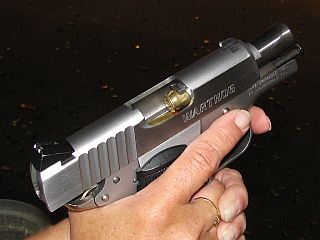 We took our weekly trip to the shooting range for target practice. This week we took Damsel’s .357 S&W 686, her .45 Warthog and my Glock 30, also .45 caliber. Additionally we took Damsel’s Remington 870 20 gauge shotgun and our 12 gauge Remington 870 security shotgun. We had 100 rounds of .45 reloads for the semi-autos and a fifty round box of .38 special for the revolver. We also brought two 25 round boxes of shotgun shells, one 12 and one 20 gauge.
We took our weekly trip to the shooting range for target practice. This week we took Damsel’s .357 S&W 686, her .45 Warthog and my Glock 30, also .45 caliber. Additionally we took Damsel’s Remington 870 20 gauge shotgun and our 12 gauge Remington 870 security shotgun. We had 100 rounds of .45 reloads for the semi-autos and a fifty round box of .38 special for the revolver. We also brought two 25 round boxes of shotgun shells, one 12 and one 20 gauge.
Image: Photo of Damsel’s Warthog misfeed – click on the image to enlarge.
Most everything went smoothly. There is one anecdotal misfeed event that Damsel had with her Warthog. She said that she flinched before squeezing the trigger and the case failed to eject. The next round in the magazine was holding the case in the barrel against the pressure of the slide spring.
Damsel went to clear the jam, but forgot to lock the slide back before ejecting the magazine. She was safely pointing the muzzle downrange when the slide snapped forward as she ejected the magazine. Coincidentally, when the slide snapped into place, the shooter in an adjacent booth discharged a round, which startled Damsel – she thought the discharge came from the Warthog. As it turned out, she had a bigger flinch than the original flinch that caused the jam.
Of course we quickly put the incident behind us in the category of lessons learned as we continued to enjoy shooting for the rest of the session.

I have seen a lot of people flinch, and have flinched myself more than I would like to admit, and have never seen a flinch cause such a jam. As a matter of fact, in all my years of shooting, and instructing, I have never seen a jam like that one – and I have seen lots of malfunctions. If I understand right, the round that is partially in the chamber is a spent casing that should have been extracted and ejected. That is a strange one to see, and it makes me wonder if tolerances for the Warthog in question are correct. I cannot imagine a flinch, or anything else the shooter could do like that, that would cause such a malfunction to happen short of a combination of shooting a dirty gun then maybe dropping it as it failed to extract all the way. There being a lot of crud under the extractor claw could have caused it to come off of the casing (a chipped extractor can cause the same thing). That in addition to maybe dropping the gun and jarring it severely to cause the next round to come up at the angle it must have in the mag to actually wind up the way it did (then again the mag could also be partially at fault). It could also be something else that I am not thinking of but I sure cannot figure it. Unusual jam indeed.
All the best,
Glenn B
Cool pic! (By the way, I posted some gun photos yesterday because I do know there are some of you who like that sort of thing)
According to Kerby Smith, Director of Communications and Public Relations at Para, the Warthog is unique in being the smallest sub-compact .45 in the 1911 style. Kerby says that fact generates its own special problems when it comes to flinching and limp-wristed grip.
This gun was jamming a lot before we watched a Todd Jarrett video in which he was training a young woman, with a body weight of 117 lbs., to properly grip a large-bore short barrel-length gun. Todd showed how to align the boresight with the forearm and to lock the wrists and elbows on the strong side. After watching the video, Damsel’s jams dropped dramatically.
We’re convinced this event was a fluke – she shot the other 49 rounds we brought to the range without incident. Two weeks prior and for the last several trips to the range, the Warthog fired flawlessly.
Compare the Warthog slide and barrel to my Glock 30, also a ‘sub-compact’ .45ACP. You can see how small this gun really is – and it kicks like a mule too – more than the Glock by a lot.